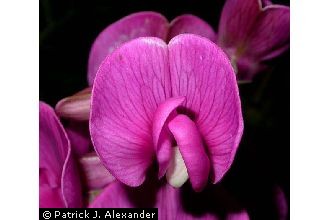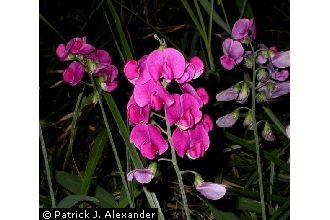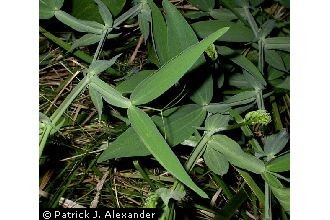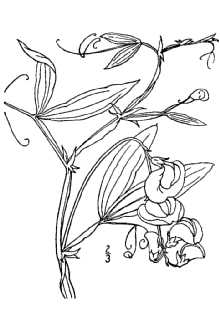Perennial Pea
Scientific Name: Lathyrus latifolius L.
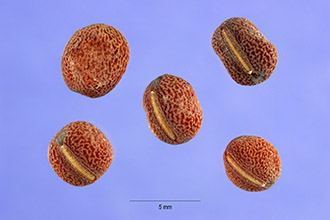
| General Information | |
|---|---|
| Usda Symbol | LALA4 |
| Group | Dicot |
| Life Cycle | Perennial |
| Growth Habits | Forb/herbVine, |
| Native Locations | LALA4 |
Plant Guide
Description
General: Perennial pea is an introduced perennial vine in the Fabaceae/Leguminosae family. The long-lived vine (Godt and Hamrick, 1991) arises from a taproot and rhizomatous root system each year. Stems are glabrous and winged. Alternate compound leaves consist of a leaflet pair and winged petiole. Leaflets are ovate to oblong with pointed tips and entire margins and up to 3 inches (7.6 cm) long and 1 inch (2.5 cm) across. A tendril for climbing grows from the leaflet base. Perennial pea blooms in spring or summer. Bloom color varies from pink, purple, blue, yellow, or white (North Carolina State Extension, 2020). Short racemes of 4 to 10 flowers arise from the leaf axils (Fig. 1). Individual scentless flowers up to 1 inch (2.5 cm) wide consist of five petals; an upper standard petal, a lower keel petal, and lateral petals. Seedpods are hairless, flattened, and about 2 inches (5 cm) long by ½ inch (1.3 cm) wide. They progress from green to brown at maturity. Mature pods twist open to throw out ripened seeds that are round and about 0.16 inch (4mm) wide (Fig. 2) (Eason, 2018; Illinois Wildflowers, 2020). Distribution: The Lathyrus genus contains 160 species from the north temperate zone, South America, and east Africa. This genus is known for its climbing or sprawling growth habit and branched tendrils (Diggs et al., 1999). Perennial pea is native to Europe and is naturalized in the United States. It is distributed widely in the US and is found from Washington State to Georgia (Godt and Hamrick, 1991). For current distribution, please consult the Plant Profile page for this species on the PLANTS Web site. Habitat: Perennial pea was introduced to North America in the early1700’s as a garden plant (Missouri Botanical Garden, 2020). Eventually the species escaped cultivation and is found along roadsides, fencerows, and old homesteads (Missouri Botanical Garden, 2020; Eason, 2018). The plants are quite vigorous and can form dense colonies covering a hectare (2.47 acres) or more (Godt and Hamrick, 1991). Natural Resources Conservation Service Plant Guide Figure 1. Perennial pea foliage and blooms. Photo credit: Dr. Robin R. Buckallew, hosted by the USDA-NRCS PLANTS Database. Figure 2. Perennial pea seeds. Photo credit: Steve Hurst, hosted by the USDA-NRCS PLANTS Database. 2
Adaptation
Perennial pea is adapted to USDA Plant Hardiness Zones 4a to 8b (North Carolina State Extension, 2020). The plant favors sites in full to partial sun that have well-drained, but not droughty, loam to clay loam soils with pH of 5.8 to 7.5 (Illinois Wildflowers, 2020; USDA, NRCS, 2020).
Uses
Plant perennial pea with other grasses and legumes to provide ground cover and wildlife habitat (USDA NRCS Rose Lake Plant Materials Center, 2014). Bumblebees pollinate the showy flowers while Fabricious blister beetles (Epicauta fabricii) and Oithona tiger moth (Grammia oithona) caterpillars eat the foliage (Illinois Wildflowers, 2020). Perennial pea is used as a garden ornamental for container, mixed border, and specimen plantings (The Morton Arboretum, 2020).
Status
Threatened or Endangered: Perennial pea is not listed as threatened or endangered (US Fish and Wildlife Service, 2020), Wetland Indicator: Perennial pea is not listed on the National Wetlands Plant List, Species not found on the Plant List are considered Upland (UPL) in all wetland regions it occurs, An upland plant is a species that almost never occurs in wetlands (US Army Corps of Engineers, 2018), Weedy or Invasive: This plant may become weedy or invasive in some regions or habitats and may displace desirable vegetation if not properly managed, Perennial pea is considered a problem plant in some western states in the U,S, It is on a monitor/watch or control list in Washington State, California, Idaho, and Wyoming (Washington State Noxious Weed Control Board, 2020; Cal IPC, 2020; Oregon Department of Agriculture, 2020), Perennial pea is a class “B” noxious weed in Oregon where it is found along right of ways, forested regions, and natural areas (Oregon Department of Agriculture, 2019; Oregon Department of Agriculture, 2020), Please consult with your local NRCS Field Office, Cooperative Extension Service office, state natural resource, or state agriculture department regarding its status and use, Please consult the PLANTS Web site (http://plants,usda,gov/) and your state’s Department of Natural Resources for this plant’s current status (e,g,, threatened or endangered species, state noxious status, and wetland indicator values), Use soil moisture sensors to measure the soil moisture of Perennial Pea.,
Planting Guidelines
Plant perennial pea in fall or early spring at a rate of 15 PLS lb/acre. There are about 8,000 seeds/lb. Perennial pea may be used as part of a mixture of perennial grasses, legumes, or both (USDA Rose Lake Plant Materials Center, 2014). Consult your local USDA NRCS Field Office for recommended planting dates and rates in your area. Take soil samples to determine soil pH and fertility before planting. Amend soil pH and fertility according to soil test recommendations for alfalfa (Medicago sativa L.) (USDA Rose Lake Plant Materials Center, 2014). Inoculate with appropriate pea/vetch rhizobium before planting. Prepare the site by mowing and applying a broad-spectrum herbicide for no till planting. Plant seed ½ to 1 inch deep using a no-till drill equipped with depth bands to control seed placement. For conventional planting, prepare a weed free seedbed using light tillage and a cultipacker to smooth and firm the seedbed prior to planting. Allow rain or irrigate to germinate weed seed and then apply a broad-spectrum herbicide to eliminate weed seedlings. Plant seed with a conventional seed drill after herbicide application. For broadcast seeding, prepare a conventional seedbed and control weeds. Broadcast the seed directly on the site and cover the seed using a drag or culti-packer to create a good seed-to-soil contact. Increase seeding rates 10-25% for broadcast seeding.
Management
Monitor plantings to maintain plant species diversity within the stand and if perennial pea is spreading outside the planting area.
Pests and Potential Problems
Perennial pea pests include slugs and snails which damage young plants along with aphids (Aphis sp.), pea moth (Cydia nigricana), and mites (Tetranychus sp.). Possible diseases are powdery mildew (Erysiphe sp.), gray mold (Botrytis cinerea), black root rot (Thielaviopsis sp.), and leaf spots (Antonelli, 2003; Missouri Botanical Garden, 2020). Consuming perennial pea seeds is not recommended as they are toxic to humans and domestic animals (North Carolina State Extension, 2020). The toxic effect is known as Lathyrism. Lathyrism symptoms in humans include paralysis, slow and weak pulse, shallow breathing, convulsions, tremors, and seizures (North Carolina State Extension, 2020). Poisoning symptoms in dogs include vomiting, diarrhea, head pressing, lethargy, seizures, and shaking (Wag!, 2020). Symptoms in horses and cattle include paralysis and/or incoordination of rear legs, unusual stance, reluctance to stand, and not able to rise (Texas A&M University, 2020).
Environmental Concerns
Concerns
Concerns
Perennial pea, with stems that can grow to 6 or more feet in a season, can smother low growing vegetation and reduce native plant cover (Eason, 2018; Oregon Department of Agriculture, 2020).
Control
Perennial pea produces seed and spreads vegetatively by rhizomes. DiTomaso and Kyser (2013) mention both nonchemical and chemical control methods. Complete mowing and cutting before flowering because the viney stems are difficult to cut in the late growing season. Repeated cultivation of the rhizomes control plants; however, it may not be appropriate for critical areas subject to soil erosion. Digging or hand pulling young plants before flowering are two labor intensive control methods. Chemical controls include both selective and nonselective compounds. Since perennial pea regrows and reproduces from rhizomes, select chemical controls which move through the plant and kill the roots (Jefferson County, Washington, 2020). Increase chemical effectiveness by applying to actively growing plants. Please contact your local agricultural extension specialist or county weed specialist to learn what works best in your area and how to use it safely. Always read label and safety instructions for each control method. Trade names and control measures appear in this document only to provide specific information. USDA NRCS does not guarantee or warranty the products and control methods named, and other products may be equally effective.
Seeds and Plant Production
Plant Production
Plant Production
Take soil samples and amend the field according to soil test recommendations before planting. Perennial pea fertility needs are similar to alfalfa (USDA Rose Lake Plant Materials Center, 2014). Plant perennial pea in fall or early spring at 15 PLS lb./acre rate. Plant seed ½ to 1 inch deep using a no-till or conventional drill. Perennial pea begins blooming in summer. Seed pods progress from green to light brown when mature. They do not ripen uniformly and will shatter when fully ripened. Plants should be dry when harvesting and a plant dessicant may help plant dry down (USDA Rose Lake Plant Materials Center, 2014). Harvest seed with a combine when most seed pods are brown but before they shatter. Use a wide cylinder and concave spacing along with a cylinder speed below 1000 RPM to reduce seed damage and cracking. Pea seed will heat if stored in sacks or a bin immediately after harvest. Stir and air-dry harvested seed about ten days or until danger of heating is over then scalp the material. Use a seed cleaner with air adjustments and separation screens to remove chaff and unfilled seed. Three screen cleaners have a top scalping screen, a middle screen with holes large enough for seed to pass through, and a third or bottom screen with holes smaller than the seeds to remove any small fines or chaff (Wolff, 1951). Screen sizes may differ each year depending on harvested seed size. The USDA NRCS Rose Lake Plant Materials Center (2014) reports average seed yields of 165 lb/ac. Store cleaned seed in a temperature and humidity-controlled environment. Seed remains viable for two to three years when stored in a controlled environment (Gardeners Path, 2020). For ornamental gardens, producing transplants from seed is the preferred method of plant production. Perennial pea does not grow well when transplanted from rhizomes (North Carolina State Extension, 2020). Begin transplants in early spring about 6 to 7 weeks before the last frost date. Nick or scuff the pea seed to increase water absorption for quicker germination. Pre-moisten potting mix, then use pots 3 to 4 inches in size and fill them with mix. Sow one seed 1 inch deep per pot and cover with mix. Place the pots in a sunny location indoors and keep at 55 to 70°F. Water as needed to keep the potting mix moist. Harden off seedlings before transplanting to acclimate them to outdoor temperatures and reduce transplant shock. Begin hardening off seedlings when they have 3 to 4 pairs of leaves. Move the seedlings outside to a place they receive morning sun and afternoon shade for 3 to 4 days, then to a spot in direct sun all day for another 3 to 4 days before transplanting (Renee’s Garden, 2020). Cultivars, Improved, and Selected Materials (and area of origin) ‘Lancer’ perennial pea was released by the USDA NRCS Rose Lake Plant Materials Center and Michigan Department of Transportation in 1986. It is used as a component in seed mixes for conservation cover, field borders, and critical area planting in the Midwest and Northeastern U.S. ‘Lancer’ is adapted to silt loam to fine sand loams with fair to good drainage but is not suited to wet soils (USDA-NRCS Rose Lake Plant Materials Center, 2014). Ornamental perennial pea varieties of magenta, pale pink, and white flowers are commercially available. New commercial cultivars are periodically reselected from superior plants and given new cultivar names (Parsons, 2013). Perennial pea cultivars currently available include ‘Albus’, ‘Blushing Bride’, ‘Pink Beauty’, ‘Pink Pearl’, ‘Snow Queen’, and ‘Splendens’ (North Carolina State Extension, 2020). Select cultivars based on the local climate, resistance to local pests, and intended use. Consult with your local land grant university, local extension or local USDA NRCS office for recommendations on adapted cultivars for use in your area. 4
Literature Cited
Antonelli, A. 2003. Pea moth - WSU PLS-59. Washington State University Cooperative Extension. Washington State University. Pullman, Washington. Cal IPC. 2020. The Cal IPC inventory – Lathyrus latifolius. California Invasive Plant Council. Richmond, California. Accessed online 8/12/20 at https://www.cal-ipc.org/plants/inventory Diggs, G., B. Lipscomb, R. O’Kennon. 1999. Shinner’s and Mahler’s illustrated flora of north central Texas. Center for Environmental Studies and Department of Biology, Austin College. Sherman, Texas. Botanical Research Institute of Texas (BRIT), Fort Worth, Texas. DiTomaso, J., G. Kyser et al. 2013. Weed control in natural areas in the western United States. Weed Research and Information Center. University of California. Eason, M. 2018. Wildflowers of Texas. Timber Press, Inc. Portland, Oregon. Gardeners Path. 2020. When and how to store sweet pea seeds. Accessed 8/17/20 at https://gardenerspath.com Godt, M. and J. Hamrick. 1991. Genetic variation in Lathyrus latifolius (Leguminosae). Amer. J. Botany 78(9). pgs. 1163-1171. Illinois Wildflowers. 2020. Everlasting pea-Lathyrus latifolius. Accessed online 8/10/20 at https://www.illinoiswildflowers.info/weeds/plants/everlasting_pea.htm Jefferson County, Washington. 2020. Peavine best management practices – everlasting pea (Lathyrus latifolius) and flat pea (Lathyrus sylvestris). Jefferson County Noxious Weed Control Board. Port Townsend, Washington State. Missouri Botanical Garden. 2020. Lathyrus latifolius. Missouri Botanical Garden. St. Louis, Missouri. North Carolina State Extension. 2020. North Carolina extension gardener plant toolbox-Lathyrus latifolius. North Carolina State University. Raleigh, North Carolina. Oregon Department of Agriculture. 2019. Noxious weed policy and classification system. Oregon Department of Agriculture. Noxious Weed Control Program. Salem, Oregon. Oregon Department of Agriculture. 2020. “B” rated weeds - Lathyrus latifolius. Oregon Department of Agriculture. Noxious Weed Control Program. Salem, Oregon. Parsons, R. 2013. Perennial Lathyrus. Plantsman: New Series 12(3). Pgs. 178-183. Renee’s Garden. 2020. Growing sweet peas-starting early indoors and transplanting: technique tips with photos. Accessed online 8/18/20 at https://www.reneesgarden.com/blogs/gardening-resources/growing-sweet-peas-starting-early-indoors-and-transplanting-technique-tips-with-photos Texas A&M University. 2020. Plants of Texas Rangelands. Virtual herbarium. Accessed online 7/25/20 at https://rangeplants.tamu.edu/plant/singletary-pea/ The Morton Arboretum. 2020. Perennial sweetpea. The Morton Arboretum. Lisle, Illinois. US Army Corps of Engineers. 2018. National wetland plant list. Ver.3.4. US Army Corps of Engineers. US Fish and Wildlife Service. 2020. ECOS- Environmental Conservation Online System. Accessed online 8/9/20 at https://www.fws.gov/endangered USDA, Agricultural Research Service, National Plant Germplasm System. 2020. Germplasm Resources Information Network (GRIN-Taxonomy). National Germplasm Resources Laboratory, Beltsville, Maryland. URL: https://npgsweb.ars-grin.gov/gringlobal/taxonomydetail.aspx?id=21580 . Accessed 18 August 2020. USDA-NRCS Rose Lake Plant Materials Center. 2014. Release brochure for ‘Lancer’ perennial pea (Lathyrus latifolius). USDA-NRCS Rose Lake Plant Materials Center. East Lansing, Michigan. USDA, NRCS. 2020. The PLANTS Database (http://plants.usda.gov, 18 August 2020). National Plant Data Team, Greensboro, NC 27401-4901 USA. Wag!. 2020. Everlasting pea poisoning in dogs. Accessed online 8/24/20 at https://wagwalking.com/condition/everlasting-pea-poisoning Washington State Noxious Weed Control Board. 2020. Perennial peavine-Lathyrus latifolius. Accessed online 8/12/20 at https://www.nwcb.wa.gov/noxious-weed-monitor-list
Plant Traits
Growth Requirements
| Temperature, Minimum (°F) | -38 |
|---|---|
| Adapted to Coarse Textured Soils | Yes |
| Adapted to Fine Textured Soils | No |
| Adapted to Medium Textured Soils | Yes |
| Anaerobic Tolerance | None |
| CaCO3 Tolerance | High |
| Cold Stratification Required | No |
| Drought Tolerance | High |
| Fertility Requirement | Medium |
| Fire Tolerance | Medium |
| Frost Free Days, Minimum | 140 |
| Hedge Tolerance | None |
| Moisture Use | Low |
| pH, Maximum | 7.5 |
| pH, Minimum | 5.8 |
| Precipitation, Maximum | 60 |
| Precipitation, Minimum | 26 |
| Root Depth, Minimum (inches) | 12 |
| Salinity Tolerance | None |
| Shade Tolerance | Intolerant |
Morphology/Physiology
| After Harvest Regrowth Rate | Slow |
|---|---|
| Toxicity | Moderate |
| Shape and Orientation | Decumbent |
| Nitrogen Fixation | Medium |
| Resprout Ability | No |
| Active Growth Period | Spring and Summer |
| Bloat | None |
| C:N Ratio | Low |
| Coppice Potential | No |
| Fall Conspicuous | No |
| Fire Resistant | No |
| Flower Color | Purple |
| Flower Conspicuous | Yes |
| Foliage Color | Green |
| Foliage Porosity Summer | Moderate |
| Foliage Texture | Coarse |
| Low Growing Grass | No |
| Lifespan | Long |
| Leaf Retention | No |
| Known Allelopath | No |
| Height, Mature (feet) | 2.0 |
| Growth Rate | Moderate |
| Growth Form | Rhizomatous |
| Fruit/Seed Conspicuous | No |
| Fruit/Seed Color | Brown |
| Foliage Porosity Winter | Porous |
Reproduction
| Vegetative Spread Rate | Moderate |
|---|---|
| Small Grain | No |
| Seedling Vigor | Low |
| Seed Spread Rate | Slow |
| Seed per Pound | 8000 |
| Fruit/Seed Persistence | No |
| Propagated by Tubers | No |
| Propagated by Sprigs | No |
| Propagated by Sod | No |
| Propagated by Seed | Yes |
| Propagated by Corm | No |
| Propagated by Container | No |
| Propagated by Bulb | No |
| Propagated by Bare Root | No |
| Fruit/Seed Period End | Summer |
| Fruit/Seed Period Begin | Summer |
| Fruit/Seed Abundance | Low |
| Commercial Availability | Routinely Available |
| Bloom Period | Late Spring |
| Propagated by Cuttings | No |
Suitability/Use
| Veneer Product | No |
|---|---|
| Pulpwood Product | No |
| Protein Potential | High |
| Post Product | No |
| Palatable Human | No |
| Palatable Graze Animal | Low |
| Palatable Browse Animal | Low |
| Nursery Stock Product | No |
| Naval Store Product | No |
| Lumber Product | No |
| Fodder Product | No |
| Christmas Tree Product | No |
| Berry/Nut/Seed Product | No |

